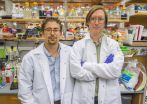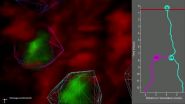(Press-News.org) A powerful scientific tool for editing the DNA instructions in a genome can now also be applied to RNA, the molecule that translates DNA's genetic instructions into the production of proteins. A team of researchers with Berkeley Lab and the University of California (UC) Berkeley has demonstrated a means by which the CRISPR/Cas9 protein complex can be programmed to recognize and cleave RNA at sequence-specific target sites. This finding has the potential to transform the study of RNA function by paving the way for direct RNA transcript detection, analysis and manipulation.
A team led by Jennifer Doudna, biochemist and leading authority on the CRISPR/Cas9 complex, showed how the Cas9 enzyme can work with short DNA sequences known as "PAM," for protospacer adjacent motif, to identify and bind with specific site of single-stranded RNA (ssRNA). They are designating this RNA-targeting CRISPR/Cas9 complex as RCas9.
"Using specially designed PAM-presenting oligonucleotides, or PAMmers, RCas9 can be specifically directed to bind or cut RNA targets while avoiding corresponding DNA sequences, or it can be used to isolate specific endogenous messenger RNA from cells," says Doudna, who holds joint appointments with Berkeley Lab's Physical Biosciences Division and UC Berkeley's Department of Molecular and Cell Biology and Department of Chemistry, and is also an investigator with the Howard Hughes Medical Institute (HHMI). "Our results reveal a fundamental connection between PAM binding and substrate selection by RCas9, and highlight the utility of RCas9 for programmable RNA transcript recognition without the need for genetically introduced tags."
From safer, more effective medicines and clean, green, renewable fuels, to the clean-up and restoration of our air, water and land, the potential is there for genetically engineered bacteria and other microbes to produce valuable goods and perform critical services. To exploit the vast potential of microbes, scientists must be able to precisely edit their genetic information.
In recent years, the CRISPR/Cas complex has emerged as one of the most effective tools for doing this. CRISPR, which stands for Clustered Regularly Interspaced Short Palindromic Repeats, is a central part of the bacterial immune system and handles sequence recognition. Cas9 - Cas stands for CRISPR-assisted - is an RNA-guided enzyme that handles the sniping of DNA strands at the specified sequence site.
Together, CRISPR and Cas9 can be used to precisely edit the DNA instructions in a targeted genome for making desired types of proteins. The DNA is cut at a specific location so that old DNA instructions can be removed and/or new instructions inserted. Until now, it was thought that Cas9 could not be used on the RNA molecules that transcribe those DNA instructions into the desired proteins.
"Just as Cas9 can be used to cut or bind DNA in a sequence-specific manner, RCas9 can cut or bind RNA in a sequence-specific manner," says Mitchell O'Connell, a member of Doudna's research group and the lead author of a paper in Nature that describes this research titled "Programmable RNA recognition and cleavage by CRISPR/Cas9." Doudna is the corresponding author. Other co-authors are Benjamin Oakes, Samuel Sternberg, Alexandra East Seletsky and Matias Kaplan.
In an earlier study, Doudna and her group showed that the genome editing ability of Cas9 is made possible by presence of PAM, which marks where cutting is to commence and activates the enzyme's strand-cleaving activity. In this latest study, Doudna, Mitchell and their collaborators show that PAMmers, in a similar manner, can also stimulate site-specific endonucleolytic cleavage of ssRNA targets. They used Cas9 enzymes from the bacterium Streptococcus pyogenes to perform a variety of in vitro cleavage experiments using a panel of RNA and DNA targets.
"While RNA interference has proven useful for manipulating gene regulation in certain organisms, there has been a strong motivation to develop an orthogonal nucleic-acid-based RNA-recognition system such as RCas9," Doudna says. "The molecular basis for RNA recognition by RCas9 is now clear and requires only the design and synthesis of a matching guide RNA and complementary PAMmer."
The researchers envision a wide range of potential applications for RCas9. For example, an RCas9 tethered to a protein translation initiation factor and targeted to a specific mRNA could essentially act as a designer translation factor to "up-" or "down-" regulate protein synthesis from that mRNA.
"Tethering RCas9 to beads could be used to isolate RNA or native RNA–protein complexes of interest from cells for downstream analysis or assays," Mitchell says. "RCsa9 fused to select protein domains could promote or exclude specific introns or exons, and RCas9 tethered to a fluorescent proteins could be used to observe RNA localization and transport in living cells."
INFORMATION:
This research was primarily supported by the NIH-funded Center for RNA Systems Biology.
Lawrence Berkeley National Laboratory addresses the world's most urgent scientific challenges by advancing sustainable energy, protecting human health, creating new materials, and revealing the origin and fate of the universe. Founded in 1931, Berkeley Lab's scientific expertise has been recognized with 13 Nobel prizes. The University of California manages Berkeley Lab for the U.S. Department of Energy's Office of Science. For more, visit http://www.lbl.gov.
VIDEO:
A software program developed by engineers at Drexel University, called Lineage Editing and Validation (LEVER), allows biologists to tag and track cell proliferation to validate lineage trees.
Click here for more information.
For hundreds of years biologists have studied cells through the lens of a microscope. With a little help from a team of engineers at Drexel University, these scientists could soon be donning 3-D glasses in a home-theater-like lab to take their own ...
FALLS CHURCH, Va. (October 3, 2014) — A new National Institute for Occupational Safety and Health (NIOSH) study, published online in the Journal of Occupational and Environmental Hygiene, found that recommended safe handling practices for workers who administer antineoplastic drugs in healthcare settings are not always followed.
Results are derived from the 2011 Health and Safety Practices Survey of Healthcare Workers, the largest federally-sponsored survey of healthcare workers in the U.S., which addresses safety and health practices relative to use of hazardous chemicals. ...
Washington, DC—The Endocrine Society today issued a Clinical Practice Guideline (CPG) advising against the use of testosterone therapy in healthy women.
The CPG, entitled "Androgen Therapy in Women: A Reappraisal: An Endocrine Society Clinical Practice Guideline," was published online in the Journal of Clinical Endocrinology and Metabolism (JCEM), a publication of the Endocrine Society. The Society updated its 2006 recommendations to address new research concerning testosterone and dehydroepiandrosterone (DHEA) therapy in women as well as advances in testosterone testing ...
Luis Fernando Velásquez-García's group at MIT's Microsystems Technology Laboratories (MTL) develops dense arrays of microscopic cones that harness electrostatic forces to eject streams of ions.
The technology has a range of promising applications: depositing or etching features onto nanoscale mechanical devices; spinning out nanofibers for use in water filters, body armor, and "smart" textiles; or propulsion systems for fist-sized "nanosatellites."
In the latest issue of the IEEE Journal of Microelectromechanical Systems, Velásquez-García, his graduate students Eric ...
Cincinnati, OH, October 3, 2014 -- Increasing rates of adolescent obesity and the likelihood that obesity will carry forward into adulthood, have led to various preventive initiatives. It has been suggested that family meals, which tend to include fruits, vegetables, calcium, and whole grains, could be protective against obesity. In a new study scheduled for publication in the Journal of Pediatrics, researchers studied whether frequent family meals during adolescence were protective for overweight and obesity in adulthood.
Jerica M. Berge, PhD, MPH, LMFT, CFLE, and ...
In the field of medicine there has often been a divide between those who focus on modern medicine and those who prefer alternative practices. But pediatrician Sunita Vohra is a firm believer there should be room for both.
A new study from Vohra, a professor in the Faculty of Medicine & Dentistry's Department of Pediatrics at the University of Alberta, and a pediatric physician for Clinical Pharmacology with Alberta Health Services, is giving insight into the use of alternative medicines by pediatric cardiac patients and how effective they are seen to be. "We wanted to ...
Tel Aviv — The incidence of type 1 childhood diabetes has been increasing rapidly worldwide. If blood sugar levels aren't well-controlled, juvenile diabetes can affect nearly every organ of a child's body. And while long-term complications of the disease develop gradually, they may become disabling and even life-threatening. The exact cause of juvenile diabetes has eluded scientists, but a new study from Tel Aviv University suggests a likely trigger before birth.
In a recent paper published in Diabetic Medicine, Prof. Zvi Laron, Professor Emeritus of Pediatric Endocrinology ...
A team of researchers, led by the Optoelectronics Research Centre (ORC) at the University of Southampton, has demonstrated a breakthrough technique that offers the first possibility of silicon detectors for telecommunications.
For decades, silicon has been the foundation of the microelectronics revolution and, owing to its excellent optical properties in the near- and mid-infrared range, is now promising to have a similar impact on photonics.
The team's research, reported in the journal Nature Materials, describes engineering the electronic band structure of laser-crystallised ...
A study conducted in more than 100 Mongolian schoolchildren found that daily treatment with a vitamin D supplement significantly reduced the symptoms of winter-related atopic dermatitis, a type of eczema. Led by a Massachusetts General Hospital (MGH) physician, the report in the October issue of the Journal of Allergy and Clinical Immunology supports the results of a preliminary study that showed similar results in a small group of children in Boston.
"While we don't know the exact proportion of patients with atopic dermatitis whose symptoms worsen in the winter, the ...
As global life expectancy increases, adults want to maintain healthy and active lifestyles well into retirement. In fact, research shows that adults think, feel and behave five to ten years younger than their actual age.1-2 But new findings from a review paper published in Age and Ageing show that approximately one out of three adults age 50 and older suffer from sarcopenia, a condition that could interfere with aging adults' ability to live a full and active life.3
Sarcopenia, as it is known in the medical field, is a condition when a person has progressive loss of ...




